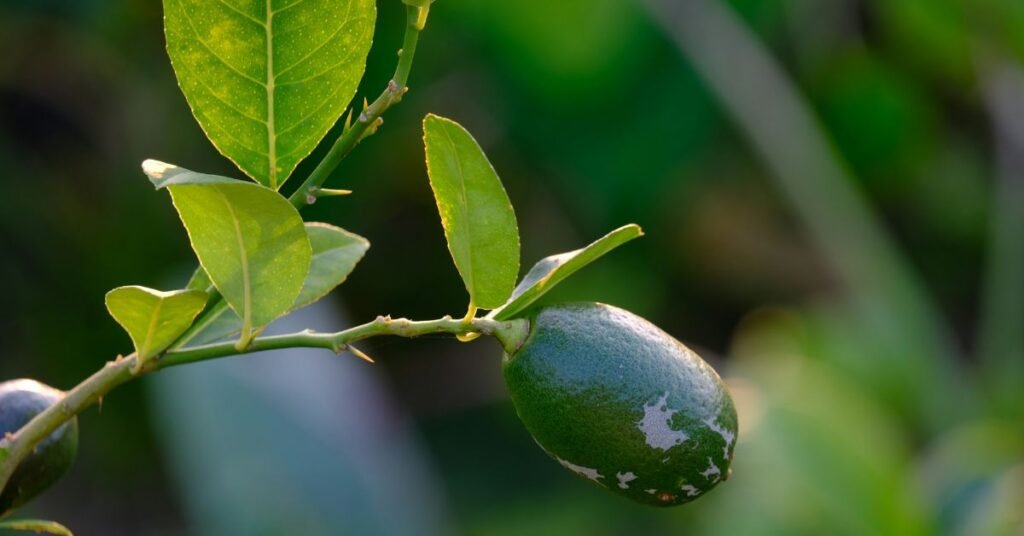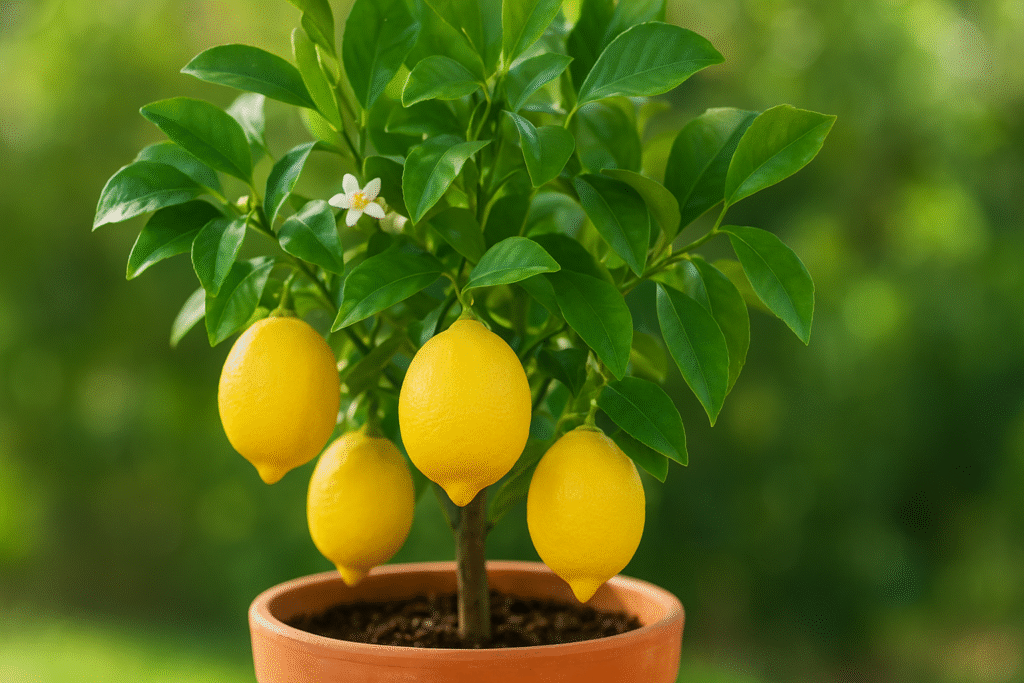Introduction
The Lemon Plant (Citrus limon) is one of the most rewarding and aromatic plants you can grow at home. With its glossy green leaves, fragrant white flowers, and bright yellow fruits, it adds both beauty and freshness to your space. Lemons are rich in Vitamin C, antioxidants, and essential oils, making them a vital ingredient in kitchens and health remedies across the world.
Whether you have a large garden or just a small balcony, growing a lemon plant is easier than you might think. This complete guide will help you learn everything about planting, caring, pruning, and harvesting your lemon tree successfully.
Benefits of Growing a Lemon Plant

Fresh and Organic Lemons
Nothing compares to the taste of a homegrown lemon. By growing your own plant, you ensure fresh, pesticide-free, and chemical-free fruit.
Air Purification
Lemon plants act as natural air purifiers. They absorb toxins from the air and release oxygen, creating a fresh environment around your home.
Decorative Appeal
The plant’s glossy leaves, fragrant flowers, and colorful fruits make it a perfect choice for gardens, patios, and indoor decoration.
Health Benefits
Lemons aid digestion, boost immunity, and hydrate the body. Regular intake helps detoxify and improve skin health naturally.
Popular Varieties of Lemon Plants
Eureka Lemon
A commonly cultivated variety known for juicy fruits and consistent fruiting throughout the year.
Lisbon Lemon
Very similar to Eureka but more tolerant to heat and wind, making it ideal for hot climates.
Meyer Lemon
A hybrid between a lemon and mandarin orange. Its fruit is sweeter and less acidic, perfect for home gardening.
Ponderosa Lemon
Produces large, aromatic lemons and prefers warm, sunny climates.
Rough Lemon
Mainly used as a rootstock for grafting due to its strong and vigorous growth.
How to Grow a Lemon Plant
1. Selecting the Perfect Location
Lemon plants love sunlight. Choose a location that receives at least 6 to 8 hours of direct sunlight daily. If you’re growing indoors, place it near a bright window or use grow lights.
2. Ideal Soil Mix
A well-drained, slightly acidic soil (pH 5.5 to 6.5) is ideal. Mix equal parts of garden soil, compost, sand, and coco peat. Add organic manure for fertility.
3. Planting Lemon from Seed
Step-by-Step Guide
- Extract seeds from a fresh lemon and rinse off pulp.
- Dry for 24 hours and sow ½ inch deep in moist soil.
- Keep in a warm, bright spot.
- Water regularly but avoid soggy conditions.
- Germination takes 2–3 weeks.
Growing from Cuttings
- Take a 6–8 inch stem cutting from a healthy plant.
- Dip the base in rooting hormone.
- Plant in moist soil and cover with a plastic bag to maintain humidity.
- Roots will appear in 3–4 weeks.

Using Grafted Plants
Buying a grafted lemon plant is a faster method. It starts bearing fruit within 1–2 years and is more disease-resistant.
Watering Schedule
Lemon plants prefer consistent moisture but not waterlogging.
- Water deeply once or twice a week depending on weather.
- In summer, increase watering frequency.
- In winter, water less often.
- Always check the top inch of soil — if dry, it’s time to water.
Sunlight and Temperature Needs
Lemon plants thrive in 20°C to 35°C temperature range. They are sensitive to frost, so protect them during cold months.
- Outdoors: 6–8 hours of direct sun.
- Indoors: Near sunny windows or under grow lights.
- During extreme cold, cover with a cloth or move indoors.
Fertilizing the Lemon Plant
Feed your lemon plant regularly for lush growth and juicy fruits.
- Use organic compost or citrus-specific fertilizer every 4–6 weeks.
- Apply nitrogen-rich fertilizer during early growth.
- Add potassium and phosphorus during fruiting for better yield.
- Mulch the base with organic matter to retain moisture and control weeds.
Tip: A homemade mix of banana peel, eggshell powder, and compost works wonders for healthy lemon growth.
Pruning and Maintenance
Pruning keeps the lemon plant in shape and improves air circulation.
- When to Prune: Late winter or early spring.
- Remove: Dead, damaged, or crossing branches.
- Shape: Keep 3–4 main stems.
- Clean tools before pruning to prevent infections.
Pest and Disease Control
Common Pests
- Aphids: Cause leaf curling.
- Spider Mites: Lead to yellow spots.
- Whiteflies: Leave sticky residue.
- Scale Insects: Form bumps on stems.
Solution: Spray neem oil or insecticidal soap every 10–15 days.
Common Diseases
- Citrus Canker: Causes brown lesions; remove infected parts.
- Root Rot: Due to overwatering; ensure good drainage.
- Leaf Curl: Caused by nutrient deficiency; feed organic fertilizer.
Flowering and Fruiting Cycle
Lemon plants produce small, white, fragrant flowers that bloom mainly in spring and summer. These flowers later develop into fruits.
- Keep soil moist during flowering.
- Avoid moving the plant too often.
- Fruits mature within 6–9 months after flowering.
Harvesting Lemons
Harvest when:
- The fruit turns bright yellow.
- Skin becomes smooth and slightly glossy.
- Fruit feels slightly soft when squeezed.
Cut fruits using scissors instead of pulling them to avoid branch damage.
Repotting Lemon Plants
Repot your lemon plant every 2–3 years.
- Choose a pot 2 inches larger in diameter.
- Trim long roots slightly before repotting.
- Replace old soil with a fresh nutrient-rich mix.
- Water well after transplanting.
Indoor Lemon Plant Care
If growing indoors:
- Keep near a bright window.
- Mist the leaves to maintain humidity.
- Rotate the pot weekly for even growth.
- Use a humidifier if the air is dry.
Seasonal Care Guide
| Season | Care Tips |
|---|---|
| Spring | Fertilize and prune lightly. |
| Summer | Water frequently; provide shade during harsh sunlight. |
| Autumn | Reduce fertilizer; inspect for pests. |
| Winter | Move indoors or cover; water less. |
Additional Tips for Success
- Avoid overwatering; it causes root rot.
- Always use containers with drainage holes.
- Add mulch to keep soil cool and moist.
- Clean leaves occasionally to allow proper photosynthesis.
- Use organic pesticides instead of chemical sprays.
Environmental and Medicinal Importance
Lemon plants not only provide fruits but also contribute to biodiversity. Their flowers attract pollinators like bees and butterflies. Moreover, lemons are used in natural medicines for digestion, sore throat, and detoxification.
Conclusion
The Lemon Plant is a true blessing for home gardeners — easy to grow, beautiful to look at, and extremely useful. With just a little attention to sunlight, watering, pruning, and feeding, you can enjoy juicy lemons all year long.
Bring one home today and let this vibrant plant add life, fragrance, and freshness to your garden!

